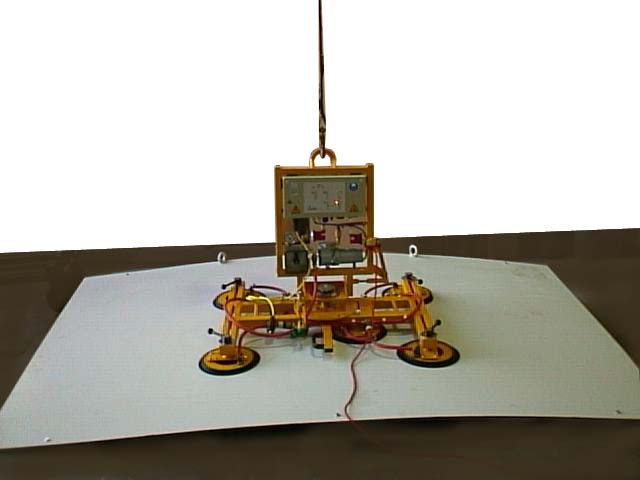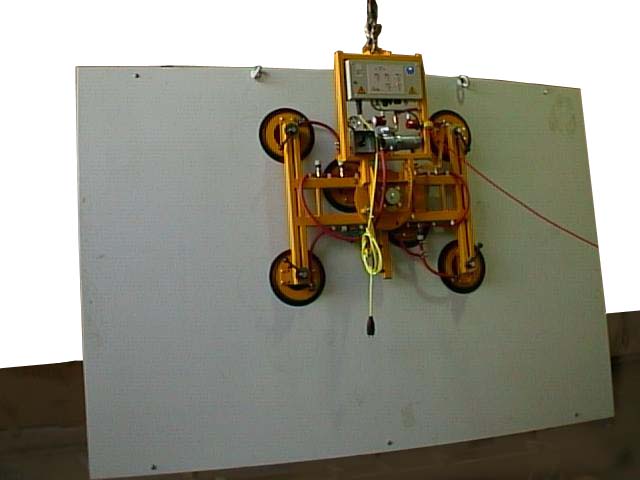Das Transportgut ist meistens eine Art Platte mit einer größeren Fläche und einer geringen Dicke. In den meisten Fällen handelt es sich um Glastafeln, Blechtafeln oder ähnliches. Eine Blechtafel, die nur in der Mitte gehalten wird, wird sich im Allgemeinen je nach Größe der Fläche und der Dicke beim Transport verformen. Dieses Biegen ist meistens für das anschließende Abstellen oder Ablegen unvorteilhaft, da so kein genaues Positionieren möglich ist.
Außerdem wird durch die auf die Sauger einwirkende Biegekräfte eine erhebliche Mehrbelastung der Sauglippen erzielt, die unter Umständen zum Ablösen des Saugers führen können.
Das Beispiel auf den folgenden Seiten zeigt die Auswirkungen, wenn ein Transportgut nicht flächenstabil gehalten wird.
Flächenstabil heißt, dass keine Verformung des Transportgutes auftritt. Ein Beispiel: Ein Blatt Papier soll horizontal (wie auf einem Tisch liegend) flächenstabil (also ohne Durchbiegen) von A nach B transportiert werden. Um dieses Stück Papier flächenstabil zu transportieren, müssen Sie es an vielen Punkten aufnehmen, die über die gesamte Fläche verteilt sind oder es wird sich durchbiegen.


Example for a not planar stabilized transport
(because the load itself does not have sufficient surface stability)
When taking into consideration the accumulator device Kombi 7011-DS it means, that:
The suction cups 388 used by us can hold onto a clean glass sheet until they detach, according to the type of force effect and speed, approx. 300 kg at a negative pressure of 0.6 bar, without consideration of a safety factor. In theory, a 7011-DS with 6 suction cups could hold approx. 1800 kg horizontally (without a safety factor).
The frame dimensions are approx. 1.0 x 0.8 m. According to our specifications it is possible to move materials up a maximum dimension of 2.0 x 1.8 m.
Take for example a steel plate with the dimensions 3.0 x 2.0 m and a weight of approx. 580 kg and you want to move it horizontally.
It would take about 10 seconds before the plate would fall down.

If you strengthen the steel plate with supports, the transport is possible, provided that you take care that no bending occurs.
During the vertical use, the stiffness is not as important because each plate material has a certain inherent stability in this direction. Pick the sheet of paper up with two fingers on one corner and hold it vertically so that the side with the 30 cm is horizontal and the 20 cm side vertical. The sheet will is suspended relatively straight without bending.
If the inherent stability is too low, the bending of the material can lead to the same effect as in the horizontal application.
When taking into consideration the accumulator device Kombi 7011-DS it means, that:
The suction cups 388 used by us can hold onto a clean glass sheet until they pull-off, according to the type of force and speed, approx. 200 kg at a partial vacuum of 0.6 bar without taking into consideration a safety factor. In theory, with a 7011-DS with 6 suction cups, one could hold approx. 1200 kg horizontally (without a safety factor).
The frame dimensions are approx. 1.0 x 0.8 m. According to our specifications it is possible to move materials up a maximum dimension of 2.0 x 1.8 m.
Take for example a steel plate with the dimensions 3.0 x 2.0 m and a weight of approx. 580 kg and you want to move it vertically.

In fact the steel plate can be held but the bending of the steel plate can already be recognized clearly. We have now reached the limit.
